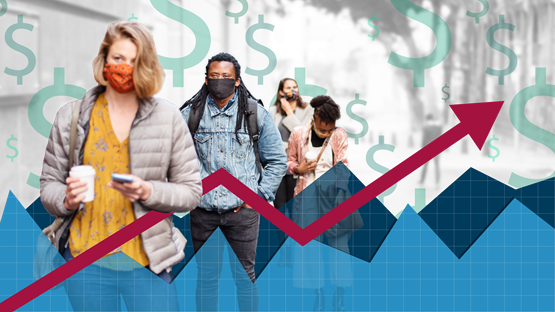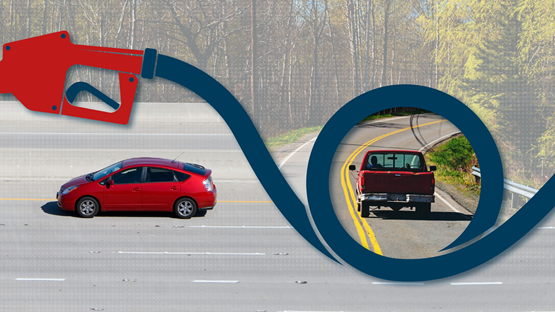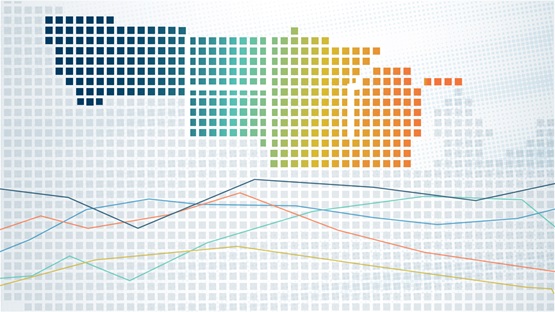Federal Reserve Bank of Minneapolis staff held six listening sessions around Minnesota and South Dakota earlier this year to increase our understanding of inflation’s effects on households and communities with limited economic resources. This article highlights what we learned by talking to about 50 residents of the Ninth Federal Reserve District. Their experiences affirm and provide important insights into economic data that highlight the ways inflation can have larger impacts on households with low incomes.
Outreach efforts can inform monetary policy
When people talk about the Fed’s role in “setting interest rates,” they’re referring to the Federal Open Market Committee (FOMC), the group of senior Federal Reserve System leaders that meets every six weeks to vote on decisions about monetary policy. Presidents from every regional Federal Reserve Bank participate in the FOMC’s deliberations and take turns filling four of the 12-member committee’s seats.
Federal Reserve Board economists regularly brief the FOMC about the state of the economy, and economists from the Federal Reserve Banks contribute to this process. At President Neel Kashkari’s request, the Minneapolis Fed has diversified its sources of information on the economy, such as the Beige Book, that ultimately help inform the FOMC’s understanding of economic conditions. This practice yields more insights into how big-picture economic trends translate to Main Streets and kitchen tables across the Ninth District and the nation as a whole.
As part of his effort to broaden the sources of information we utilize to understand the economy, President Kashkari has incorporated new outreach work by the Minneapolis Fed’s Community Development and Engagement team. The listening sessions discussed here are part of that outreach.
Higher wages (and harder work), but no added economic security
For the past seven years, hourly pay increased most quickly for workers paid the lowest wages. Meanwhile, prices rose for everyone.
Have increasing wages left low-income households feeling better off economically, even with rising prices? For many of our listening session participants, the answer was a firm “no.”
“I work seven days a week to cover my expenses,” said a participant who drives passengers at an airport. “Before, I used to work 40 hours a week. Now it’s taking me 70 hours just to cover my expenses, at two different companies.”
“People don’t realize that [Minnesota law] sets the minimum wage so it goes up with inflation, but the prices keep changing after they raise the wage,” said one worker in the child care sector. “You’re behind the curve, stuck in a box.”
Some participants received raises or had switched jobs to access higher wages but explained that their new earnings went to pay for necessities. Union members explained that their contracts last several years—and negotiated wage increases are not pegged to inflation.
“We get a raise, but then the cost of everything goes up, so it feels the same,” said one union worker. “It’s like you can’t win.”
Some participants felt their ability to increase their earnings by taking higher-paying jobs was limited due to time or resource constraints. Caregivers—those responsible for children, elderly relatives, or others—seemed particularly likely to describe constraints on their economic mobility.
Some parents described the havoc to their schedules caused by their inability to access reliable child care, a problem made worse by the pandemic. Other parents described the employment challenges they faced because of pandemic-related school and child care closures, unreliable school bus service related to driver shortages, and the need to care for sick children or adult family members.
“Child care cuts into my income and if it’s not available, then I can’t go to work. I feel like I’m struggling to get going at all,” said one participant.
Before, I used to work 40 hours a week. Now it’s taking me 70 hours just to cover my expenses, at two different companies.
“A lot of our child care providers shut down during COVID and haven’t come back,” said another. “The ones that are operating are always full.”
Transportation was another oft-cited barrier to higher wages. Rural listening session participants noted that the price of gasoline and a lack of access to reliable vehicles limits people’s ability to find and keep work in the first place. The impact of high gasoline prices on work weren’t limited to rural areas, though.
A substitute teacher in an urban area said they have shrinking options for work sites—a long drive is now too expensive relative to their wages. A former home health aide was required to drive to her clients’ homes in her own vehicle. She quit because her employer did not increase her travel reimbursement, even as gas prices continued to climb. Some workers, like janitors, said they have to pay for work-related costs beyond transportation. The price of these supplies has also gone up, without a corresponding wage increase.
Participants also felt the impact of another much-discussed labor market trend: the shortage of employees. Some workers felt they were being asked to do more at the workplace while treading water financially. “Sometimes I can’t take my break because of all the work I have to do,” said one janitor.
Another added that her employer was trying to cut company costs by requiring the same amount of work in fewer hours. “[My employer] tried to cut my hours, but I wouldn’t let them,” she said. “I told them it isn’t possible [to clean everything I need to] in less time. I physically can’t work any harder. So I was adamant and said no.”
Few options, tough choices when facing higher prices
One way economists expect consumers to react to higher prices is by substituting cheaper alternatives for their usual goods. Data show that higher-income households can find more savings than lower-income households using this approach.
For example, grocery shoppers with higher incomes might usually buy brand-name packaged food, premium cuts of meat, and organic produce. These shoppers can save money by switching to a store brand, cheaper proteins, or conventional produce when they fill their carts.
People with low incomes have fewer options: in many cases, they were already buying the cheapest brands before inflation took off. And inflation did not pass over low-cost retailers, either—as we heard in every listening session, the term “dollar store” is no longer accurate.
From May 2021 to May 2022, food prices increased by 10 percent. Unsurprisingly, grocery bills were the first thing on many of our participants’ minds when we asked them where they’d noticed higher prices.
“When money was tight, we used to say, ‘We’ll just get beans and eggs, we’ll be fine,’” said one working mother. “Now, you can’t even get eggs. We can’t even afford to get a bag of Maseca [to make our own tortillas].”
The increased price of gasoline further limited opportunities to save money because it reduced the value of taking multiple trips to access the best prices across different stores. This was particularly important for residents of rural areas and reservations, where gas prices prevented shoppers from driving a long distance to access the lower grocery prices in urban areas.
I was thinking about moving in July. Prices were $1,800 to $2,100 for a unit with everything that I need. They were $1,500 last year, maybe $1,450. There are still some cheaper units out there, but it’s really competitive [to lease one].
When it came time to renew my car insurance, it went up $80 a month. The only reason they gave me was, “everything is going up.” Everything stayed the same in the policy except the price.
“I only drive to get basic necessities, maybe a couple times a month,” said one participant. “If I have the gas money to go to [the city to shop], I go. If I don’t, I stay. [The uncertainty] is scary.”
Some participants have changed their diets in order to save money. Canned fruits and vegetables are taking the place of fresh produce. Others are supplementing their purchased food by growing a garden.
Renters in our meetings said the housing market also stressed their finances. Many felt their rents were too high to allow them to save. Others doubled up, combining households to try to save money—an approach that could be stressful for families with older members during the pandemic.
Some felt stuck in place: if they wanted to leave their current rental, they expected they’d have to pay much more for similar housing. These comments reflect increases to the Consumer Price Index, one frequently used tool for measuring inflation. Urban renters are paying an estimated 8 percent more in May 2022 than in March 2020. Zillow reports that the median rents for all listings—in other words, for listings that include rental prices offered to new tenants or for newly constructed rental units—have increased by more than twice that over the same period, indicating that prices are likely to continue to rise. Even before any price increases in the rental market, households with low incomes spent a greater share of their money on rent than households with higher incomes.
“I was thinking about moving in July,” said one renter. “Prices were $1,800 to $2,100 for a unit with everything that I need. They were $1,500 last year, maybe $1,450. There are still some cheaper units out there, but it’s really competitive [to lease one].”
Beyond their grocery and rent expenses, people described the stress caused by price increases on other essentials like car insurance premiums, auto repairs, and utilities. The Internet was described as a new necessity for families with children participating in distance learning. Most people felt the narrow options for such essentials provide them with little wiggle room. Some began performing their own car and home maintenance with the help of online do-it-yourself videos.
When costs for necessities increased, the reasons why weren’t always clear.
“When it came time to renew my car insurance, it went up $80 a month,” said one participant. “The only reason they gave me was, ‘everything is going up.’ Everything stayed the same in the policy except the price.”
With few options to limit the costs of necessities, many participants described efforts to cut out “nonessential” spending. In some cases, this meant ending a subscription to a streaming service, avoiding meals at restaurants, or skipping makeup. Other cutbacks were described as having a larger impact on participants’ well-being. People skipped visits to loved ones, told children they could no longer participate in extracurricular activities, and, for immigrant families, reduced the amount of money they sent to relatives in their country of origin.
Safety net isn’t catching all struggling households
Several participants in each session described frustrations in trying to access public benefits intended to support economically struggling families.
First, funding limits mean that safety net programs that subsidize household costs for child care and housing simply were not available to all eligible people. For example, there are waiting lists for subsidized housing or housing vouchers in many housing markets in the Ninth District. And in many places, programs that provide or subsidize child care, or assist with energy expenses, have similar waitlists or shortfalls.
Second, income-eligibility limits do not necessarily reflect recent changes to the cost of basic necessities. While some federal and state programs do have eligibility limits tied to an inflation-sensitive measure, such as the federal poverty level, these programs are typically adjusted annually instead of at intervals throughout the year. Some participants noted that recent price increases led them to apply for public assistance for the first time. Several were surprised to learn that they were ineligible for any form of assistance despite feeling like they were living paycheck to paycheck.
“We earn a paycheck and try to apply for government services, but we’re denied because we make too much—but we’re barely making enough to support ourselves,” said one working father. “How does the government come up with these thresholds? How does the government decide that we make too much to be accepted when we can barely afford to live?”
I can’t work more than a certain number of hours or my Social Security benefits will go down. I want to work more to give more to my kids, but I feel like I can’t.
Third, the level of public benefits (and other sources of income, like child support payments) may not automatically adjust to reflect the increased price of basic necessities, either. Like income eligibility, some programs feature automatic adjustments to the financial resources they provide. Others do not.
In this way, inflation decreased the ability of cash-like programs like the Supplemental Nutrition Assistance Program to help families meet their needs. It also affected medical benefits. For example, participants noted that in the past, dentists were often reluctant to serve people using public health insurance because of low reimbursement rates. Dentists were even less likely to do so now that inflation had further decreased the value of those reimbursements.
“Our old dentist retired and I can’t find someone in town who [will accept public dental insurance],” said one father. “I had to drive [three hours each way] to get my son’s teeth fixed. It’s cheaper to miss a day of work and drive that far than it would be to pay out of pocket.”
Finally, several people noted that they made decisions about whether to work more or pursue higher-paying jobs based on the potential impact on eligibility for public benefits. These participants estimated that they would actually be worse off if they worked more. In some cases, their overall income may be lowered as a result of the trade-off between private income and public assistance. In others, the trade-off might be worth it economically but feel too risky in an uncertain job market.
“I work part-time but if I work more I start to lose benefits and it isn’t worth it [financially],” said one woman. “Just when you’re starting to get ahead, they cut you down.”
“I can’t work more than a certain number of hours or my Social Security benefits will go down,” said one working mother who lost her husband to COVID-19. “I want to work more to give more to my kids, but I feel like I can’t.”
A frustrating inability to save
Data show that families with limited economic resources generally devote a majority of their income to necessities. Across all the listening sessions, participants made it clear that they were constantly evaluating opportunities to save money and trim excess expenditures.
“I know I can get to school and back 22 times in a month. I can afford that,” said one mother. “But if my kids get sick [and I have to make extra trips to pick them up], I’m going to struggle. Then it’s like a domino effect. Should I pay $5 to get gas or to buy food?”
For the most part, participants said pandemic-related relief was helpful. A few people in each session were well-informed about local efforts to distribute federal relief in forms such as scholarships, energy assistance, and work opportunities. Free food, delivered via nonprofits and churches, was described as particularly important.
“I know when all the free, hot meals are available [in our area], and I’d go to each one. They helped a lot,” said one mother. “On weekends [when these resources were unavailable], it was harder to feed my children.”
My dream is to save up money and buy a house. But if rent keeps going up, I can’t save to buy one.
Some participants increased their savings by selling assets, like older cars that have risen in value due to pandemic-fueled demand. Others were able to save the dollars that came their way from federal or state efforts to support households directly, like the temporary increase to the Child Tax Credit.
“I’m a penny pincher anyway, but when we got the [temporarily expanded] Child Tax Credit, I put it all in savings,” said one unemployed father. “That’s what we’ve been falling back on.”
Several participants described their frustration at an inability to put money away or build equity despite such efforts. Some described homeownership as an opportunity to reduce monthly expenses, since mortgage payments are largely fixed over time, while rents typically rise year to year. Several participants noted that mortgage payments for a single-family home may be lower than market-rate rents for apartments in their area.
However, an inability to save enough for a down payment frustrated some renters’ desires to own a home. “[Lenders] tell me I can’t get a loan for a $900 mortgage payment, but I’m paying $2,100 a month for rent,” said one mother who was juggling part-time college, caring for her elderly parents, and working full-time. “How does that make sense?”
“My dream is to save up money and buy a house,” said one child care worker. “But if rent keeps going up, I can’t save to buy one.”
Little optimism or faith in institutions
Of the dozens of people who attended our listening sessions, only a handful expressed optimism about the future. Participants with a positive view of the future generally felt that things would improve if the pandemic winds down, if the war in Ukraine ends, or if companies are able to resolve supply chain issues.
However, most people felt that the cost of living would continue to outpace their income. While most acknowledged the challenges caused by current supply chain snarls, they also felt that their employers, private industry, and others were exploiting the situation.
“People say the prices are going to go down. But they aren’t, because [distributors] don’t want them to,” said one laid-off Twin Cities area resident. “We may get raises but those prices will never come down.”
“Even if they raise our wages—which I doubt will happen—I feel like these companies we work for just don’t care,” said one mother who worked as a cleaner. “I think the price increases should really worry us. There must be a way to do something about it. Otherwise, it’s all a hopeless future.”
For these participants, recent experiences with inflation were not described as a break from the norm. Instead, inflation was the latest challenge in a series of economic hardships, inseparable from the continued impacts of the pandemic.
More for us to learn
No two people experience inflation in the exact same way. A dollar’s mileage varies depending on a household’s regular expenses and consumption choices, but also on just plain luck. If a household’s vehicle suddenly broke down in 2021 instead of in 2020, for example, the costs of replacing it were likely much higher.
This isn’t news. A growing number of economists, including some within the Federal Reserve System, are investigating different angles for measuring and analyzing inflation. Researchers are also producing new work about different aggregate inflation levels across demographic groups. Outreach efforts like those described here—and undertaken by our peers at other Federal Reserve Banks—are informed by and complement these analyses. Collectively, the work of Federal Reserve economists and outreach staff will improve our understanding of the health of the economy and the financial well-being of different types of households and communities, and that understanding will inform the FOMC’s decisions.
Minneapolis Fed staff will continue to convene listening sessions in the Ninth District to discuss inflation. We will post what we’ve learned from our next round of meetings in the fall.






